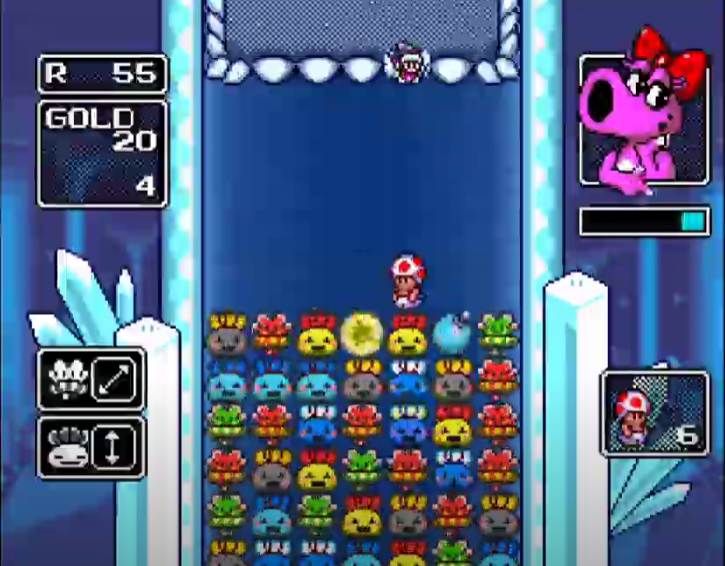Although Wario’s Woods (1994) seems to draw inspiration from the puzzle games like Tetris and is a part of the Mario franchise, this game has much more perverse messaging than its predecessors. In Wario’s Woods, you play as Toad and attempt to navigate a series of dropping-tile puzzle games in order to defeat, you guessed it, Wario himself.
Despite drawing inspiration from the puzzle game genre, rather than being a non-diegetic force that moves puzzle pieces around, the player is Toad himself. Being Toad sounds cute, it sounds like an enjoyable experience but the reality is that being Toad is anything but that. The game’s mechanics are incredibly difficult to master because there are so many options like: picking up minions/bombs, pushing them, lifting stacks of them, dropping the bottom of stacks, climbing around the puzzle pieces, and being able to jump above them. This wide array of tools can make the players’ experience dizzying, any small misclick can lead to you being trapped amongst the multitude of minions.
Luckily, throughout your puzzle solving journey you will receive support from Birdo and her pixie friends. Birdo appears in a window in the top right of your screen with a timer, during which you receive multiple bombs to blow up your enemies (Isn’t it ironic that the heroes are blowing up creatures for simply existing?). After her time runs out, Wario will be in the window and his bug will provide you with more enemies in order to disrupt your progress! They continuously shift back and forth between Birdo helping and Wario disrupting throughout every round.
Wario will also occasionally hit the stage and lower the ceiling. When the ceiling is lowered, you can be trapped more easily. This tree is revealed to have a frowning mouth and menacing eyes, almost as though it was being hostile towards both the player and the minions inside its space by taking up a part of it. This ceiling dropping emphasizes the issue of space that was already happening because of the constant production of minions.

To signify progression in the game, the stage gradually progresses between settings such as a forest, a desert, and an iceberg. The aesthetics of Wario’s Woods remains faithful to the Mario franchise yet it also subverts its environmental storytelling where the final part ends within a castle. Instead the game stays loyal to its title by ending within the woods, this progression between outdoor spaces helps place an emphasis on nature itself. It makes what could be a mundane game at least feel slightly fresh.
When I was first playing this game, I found myself confused as to what exactly the coins contributed to the narrative or mechanics of the game. However, when I finally reached my fortieth stage, I got covered in blocks and lost a life (before this I had no idea there was event a life counter)! After this, I continued to play and finally realized that toad gains these lives by collecting coins. Although this mechanic may feel tangential to the story itself, I feel as though the mechanic is very capitalist in general. The faster Toad can work, the more money he earns, and the more valuable his life is to the game.
I want to take all the aspects of the game I have discussed thus far one step further. Wario’s Woods is a puzzle game set within nature and within the puzzle genre, there is always a problem to be solved. Because it is set in various natural settings like the woods, desert, and ice this means that the game is likely grappling with an environmental issue. The stage itself is set within a tree in the forest sections and the problem that needs to be solved is the overpopulation of Wario’s minions. To do so, Birdo and her pixie friends provide Toad with bombs to control and eliminate the number of minions. This pressure to kill the minions is furthered by nature itself deteriorating and closing the space in. Yet, Toad himself is in a privileged position where the money he makes saves him from death itself, his life has value because he is productive whereas the minions are disposable because they simply exist. In other words, the game pushes the player into feeling as though killing these minions is justified by taking advantage of the generic tropes of puzzle games where one has to solve the problem. The game normalizes population control in order to promote ecofascist ideals. It is ok to kill, as long as it is for the good of nature.
I found that playing Wario’s Woods was a frustrating experience because of its complex mechanics and even more frustrating when I started to sit with the narrative of the game itself. I can say with confidence that Wario’s Woods subverts the lighthearted nature of other “Mario games” and makes use of the puzzle genre to do so effectively. Wario’s Woods is a game that is anything but fun and that it should stay buried amongst the multitude of games within the Mario franchise.
